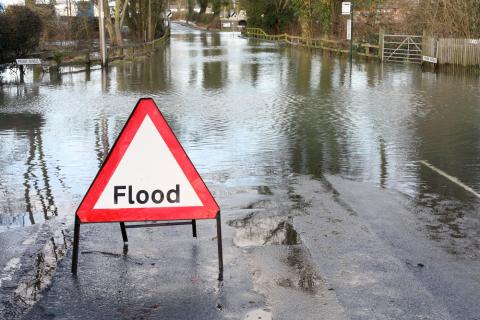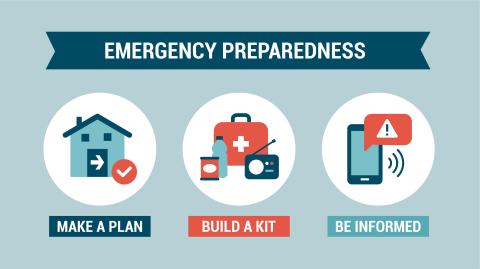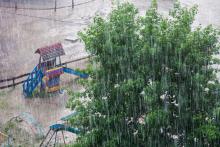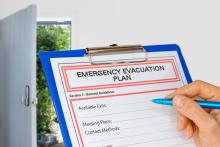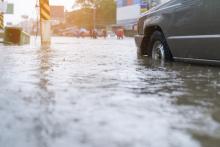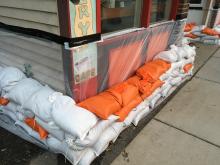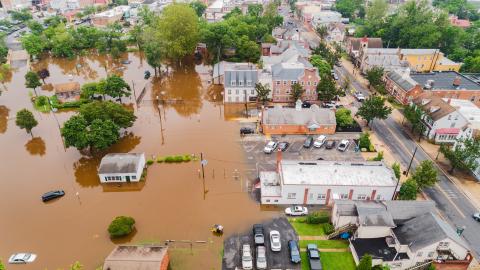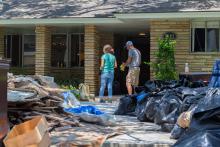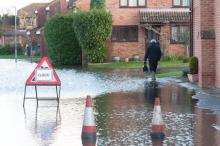Climate and Health: Flood Hazards and Recovery
Take these steps to stay safe before, during and after a flood
Floods are the most common and costly natural disasters in Wisconsin and they can happen anywhere in the the state at any time. Wisconsin's changing climate is bringing more frequent and intense rainfalls, and unpredictable floods. Warmer winters are also causing more winter floods from snowmelt and ice dams.
These climate-fueled conditions are creating more health and safety risks from flash flooding to property damage and financial stress. Hear from a Wisconsin business owner on her experiences with flooding, the physical risk to her and her employees, and the mental health strain flooding caused on the climate and health videos page.
Select the titles below to learn what you can do to:
- Prepare for floods.
- Stay afloat during floods.
- Safely clean up after floods.
Make a plan
- Prepare a family emergency kit with personal items, food, and critical supplies. Help older family members and neighbors, especially those with mobility issues, prepare one too. CDC (Centers for Disease Control and Prevention) has suggestions on what to include.
- Keep a list of emergency phone numbers in a visible place at home and create a separate emergency contact list in your phone.
- Contact your local health department or Tribal health center to familiarize yourself with community flood, emergency, and evacuation and shelter plans.
- Map a safe evacuation route in advance to higher ground, shelter or safe location.
- Move important things off the ground and to upper floors of your home if possible.
- Speak to your insurance company about flood coverage.
- Keep your cell phone charged.
Secure your home or workplace
Check with your property owner to see if the following flood protections are in place if you rent your home, or plan over time to make these improvements if you own your home:
- Raise your electrical components, furnace, and water heater above the flood zone level if you live in a flood zone.
- Install backflow valves for drains, toilets, and other sewer connections.
- Install sump pumps with backup power.
- Find the location of your electrical breaker box, and gas and water shutoff valves in case you need to evacuate your home.
- Inform local authorities about any special needs that could affect someone’s well-being in a flood—for example, a person confined to a bed or someone with a disability that affects their mobility.
Take action when a flood watch or warning is in effect
A Flood Watch means a flood is possible in your area.
A Flood Warning means a flood is about to happen or is happening in your area.
- Stay informed and listen to local weather reports.
- Gather your emergency supplies.
- Turn off the power.
- Do not walk through floodwater. If water levels begin to rise, immediately seek higher ground.
- Check on friends, family, neighbors, and co-workers who may be isolated, unaware of the flood risks, or unable to leave their home without assistance.
- If time allows:
- Bring outdoor equipment like trash cans or furniture inside or tie them down securely.
- Fill bathtubs, sinks and bottles with clean water.
- Prepare for evacuation and sheltering at a safe location. Identify a location that accommodates pets if needed.
- Make transportation arrangements or make sure your gas tank is full if you have a vehicle.
- Collect important documents including identification cards, insurance cards and medical records.
If an evacuation is ordered
- Listen for disaster sirens and warning signals.
- Check for weather conditions on radio, television or phone apps.
- Follow evacuation orders and evacuation routes.
- Turn off natural gas, electricity and water.
- Disconnect appliances.
- Take your emergency kit, supplies and items needed to care for children and pets.
- Listen to weather reports and avoid flood zones.
- Put livestock or breeding animals in a safe area.
If you're in a vehicle
- Do not drive around barriers.
- Do not use roads that are marked closed. Follow detours.
- Listen to public safety officials.
- Do not drive through floodwater. Even shallow water can float a vehicle.
- If your vehicle stalls in floodwater, get out and move to higher ground.
- Avoid driving at night when visibility is reduced whenever possible.
If you're at home or work
- If water is approaching your home or structure, don't wait—get out and move to higher ground.
- Dial 211 on your phone to find a shelter location near you or one that accommodates pets.
- Wash your hands with soap and clean hot water after touching floodwater.
- Do not eat or drink anything that has touched floodwater.
If you're outside
- Stay away from floodwater. Water can be very deep and rise quickly. There are also underwater hazards that may not be visible.
- Do not walk through floodwater. Even shallow water can move quickly and become dangerous.
- Stay away from fallen electric lines. Electricity can travel through water and hurt or kill you.
- Do not go into a home that is flooded unless you are sure the power has been turned off.
Stay out of floodwaters until they've gone down to normal levels
Never wade, swim or bathe in flooded rivers, streams, creeks, or lakes. floodwaters may contain dangerous chemicals, bacteria and hazardous materials including:
- Sewage
- Fertilizers and pesticides
- Gasoline
- Heavy metals
- Hazardous materials or large chunks of debris, including fallen tree limbs or power lines and metal or sharp objects like fence posts and nails, etc.
Safely re-enter your home or workplace
Floodwaters in and around your home and workplace can cause injuries and health problems. Do not return to any structure until the water has gone down and officials from your city or town confirm it's safe.
- Before entering a flooded home, assess any potential hazards to avoid injuries and other health and safety risks.
- Learn more about important health topics and tips when re-entering your home, P-00631a (PDF), including natural gas and electrical safety, cleaning up after water damage, and food safety.
Take proper safety measures when cleaning up after a flood
- Homes and buildings that have been flooded should be inspected by a licensed building inspector for structural damage before returning.
- If your basement is flooded, don’t rush to pump it out. If you drain your basement too quickly, the pressure outside the walls will be greater than the pressure inside, which may cause the basement floor and walls to crack and collapse.
- Broken water pipes may have created puddles in your home. Do not use electrical appliances while standing in water as it can cause electric shock or electrocution.
- If you get a cut or puncture wound while cleaning your home, tetanus shots are available through your local public health department, Tribal health center or health care provider.
- Damaged or wet flooring, carpeting, furniture, drywall, insulation, etc. should be removed and disposed of to prevent mold growth.
- Use caution when cleaning and disinfecting your home with bleach. Never mix bleach with ammonia or any other cleaners as these combinations create dangerous, toxic gases. Many household cleaners contain ammonia. Follow safety recommendations for cleaning and sanitizing surfaces with bleach and water.
Public drinking water
After a flood, public water (cities, towns, villages) users should:
- Follow any "boil water" notices or other directions from their water utility or local health department.
- Run their faucets for at least five minutes before using water for drinking or food preparation.
Private drinking water wells
When groundwater wells flood, bacteria and other harmful organisms can get into your drinking water. Your well is considered flooded if:
- The well head was covered or well casing was inundated with water.
- You notice changes in the taste or color or the presence of sediment in your water.
- Your well is shallow-cased and nearby areas that have been flooded.
If a private well has been flooded, visit the Flooding: Private Wells page for details on how to stay safe.
Before a flood hits, assess your community's flood risks with Wisconsin's Flood Resilience Scorecard! The Wisconsin Climate and Health Program and the University of Wisconsin (UW) Sea Grant created the Flood Resilience Scorecard (FRS), an online flood planning checklist that helps local governments and communities:
- Assess past, current, and projected flood impacts holistically.
- Identify ways to improve their flood-readiness with customized recommendations and links to funding opportunities and technical assistance resources.
- Complete the FRS process quickly with compiled data needed to fill out the checklist.
Contact your town, village, city or county to find out the status of your community's flood plan or hazard mitigation plan. Encourage them to use the FRS to improve their flood-readiness to protect community members from flood-related health hazards.
Here are additional resources on health and safety impacts from floods:
- The Wisconsin Department of Health Services' (DHS) Wisconsin Flood Toolkit, P-00631 provides general guidance on flood safety for health professionals and the public.
- DHS Risk Assessment Flood Tool integrates 32 flood-relevant spatial data layers in ONE customizable ArcGIS map to help government agencies prepare for and respond to floods.
- The Wisconsin Department of Natural Resources (DNR) provides resources and guidance on recovering from a flood, how to take a well sample, and other information about what to do if your well floods.
- The Wisconsin Department of Agriculture, Trade and Consumer Protection (DATCP) has a variety of flood resources on food safety, agricultural damages or losses, home repairs, animal feed, manure issues, flooded farmland, storage tanks, and pets and livestock.
- DATCP also has a variety of resources through the Wisconsin Farm Center, including emotional wellness and financial consulting, for farmers and agricultural workers experiencing challenges.
- CDC has additional information on how to prepare for a flood, stay safe during a flood, and protect your health after a flood.
- The Federal Emergency Management Administration (FEMA) has flood resources for homeowners on flood insurance, how to protect your property from floods, and rebuilding or retrofitting your home after a flood.

